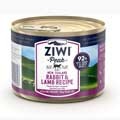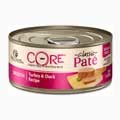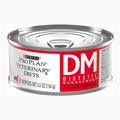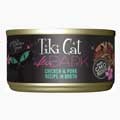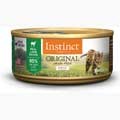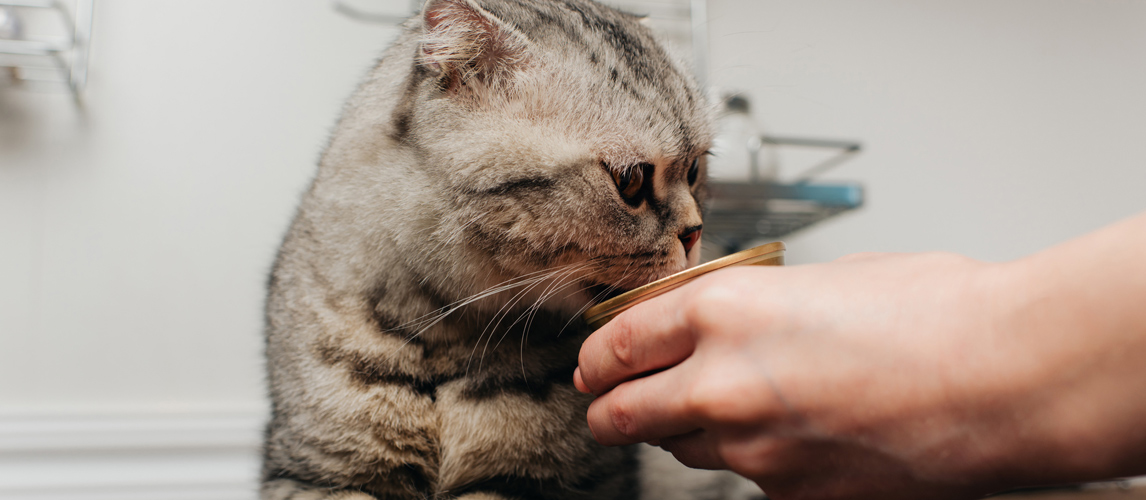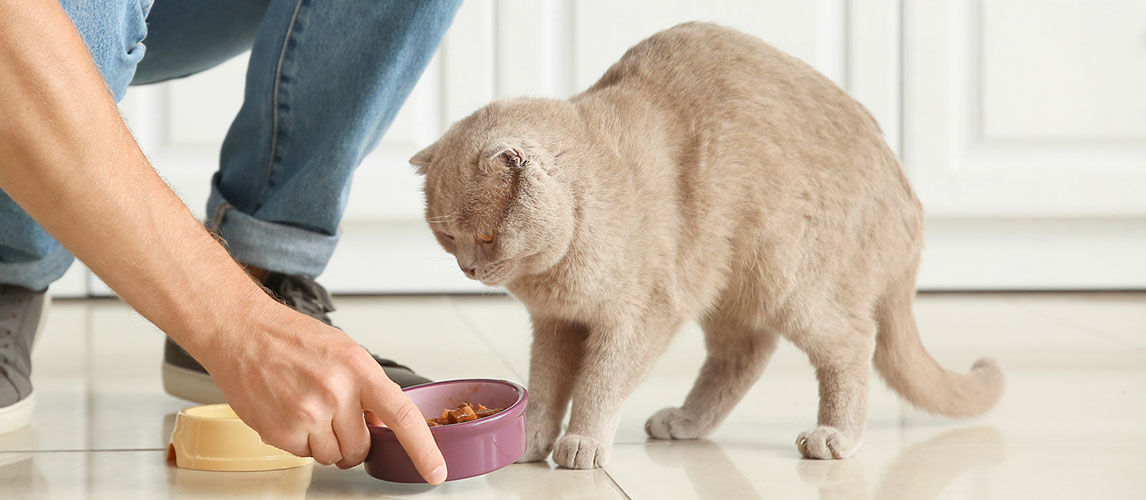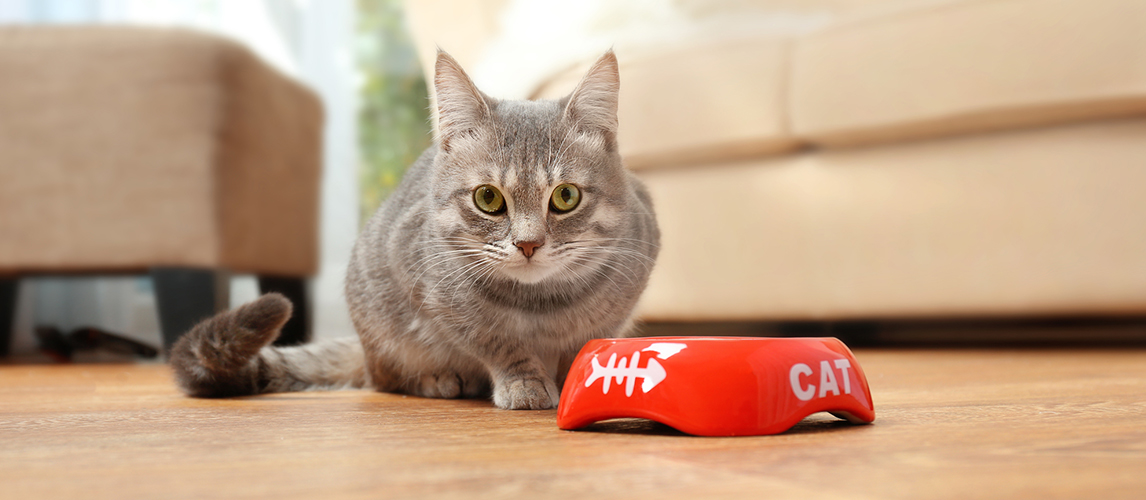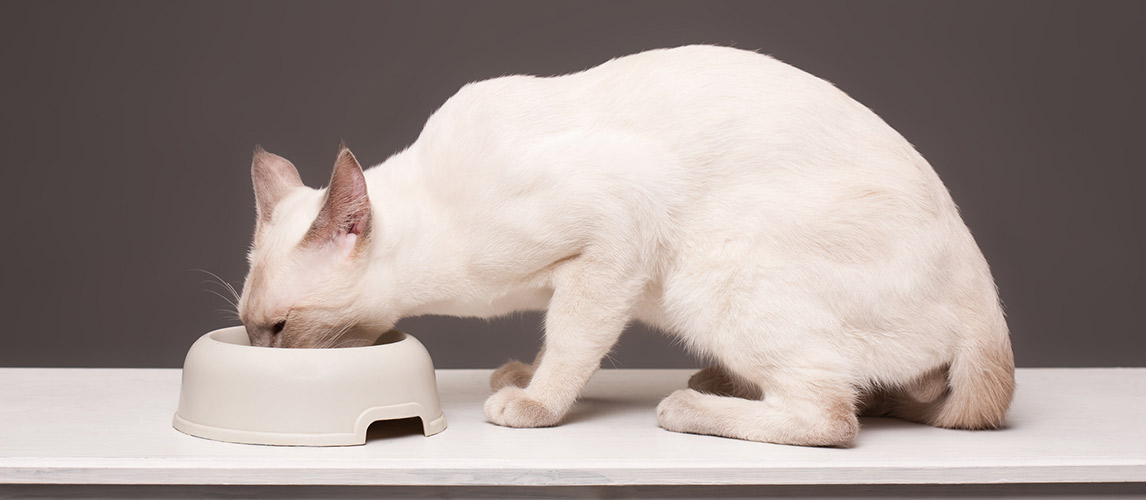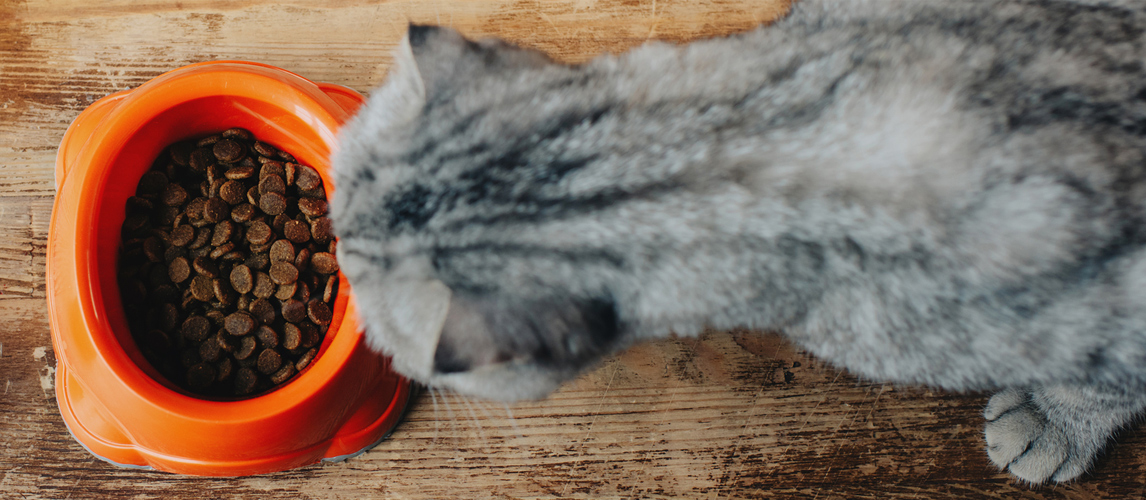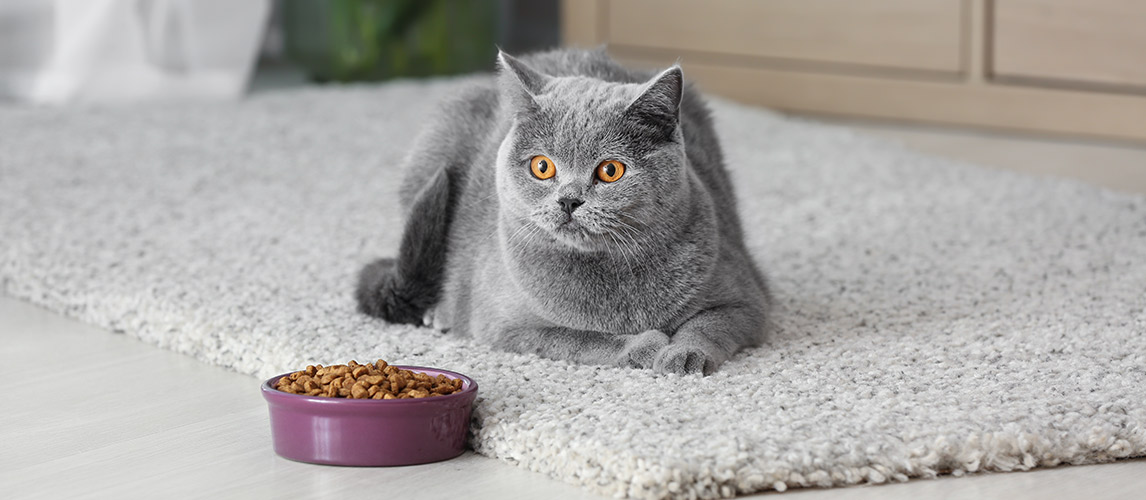It can be difficult to pinpoint the right food for diabetic cats, as their diets require more nuance and careful monitoring than your average kitty. Not only are you having to find food with the correct selection of ingredients, but you're having to consider additional potential requirements such as whether or not they are fussy and will only eat certain flavors of wet food. You will also have to remove dry cat food as an option, unfortunately!
Fortunately for you, we've taken a good look at the food available for cats that struggle with feline diabetes and hope to make your cat food shopping experience just a little easier by narrowing down the options. We've even included a buying guide with all of the key information you might need in order to better understand the needs of diabetic cats and help you to find the best diabetic cat food for your feline friend.
Key Takeaways
- - The best cat food for diabetic cats contains 10% carbohydrates or less on a dry matter basis.
- - Wet cat food is better than dry due to the low carbohydrate percentage.
- - The sooner a cat is treated for diabetes, the easier the treatment will be.
- - Feline diabetes symptoms include excessive thirst or hunger, weight loss, and increased urination.
- - Cats can enter diabetes remission, but they can't be cured of it entirely.
- - Less severe cases of diabetes can be controlled with a low-carb diet, though some diabetic cats may need insulin shots.
Our Choice of 5 Best Diabetic Cat Foods
1 Ziwi Peak Rabbit & Lamb Recipe Canned Cat Food
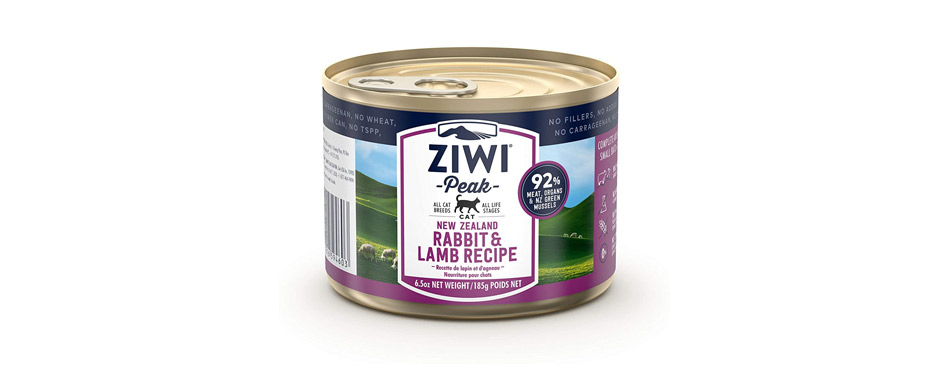
- Carbohydrates: 6.8%
- Brand: Ziwi Peak
- Allergens: n/a
- First 5 ingredients: Rabbit Meat, Water Sufficient for Processing, Lamb, Lamb Lung, Lamb Liver
- Primary Proteins: Rabbit, Hare, Lamb
- Calories: 81 kcal/3-oz can
- Flavor: Rabbit & Lamb
- Type: Wet Cat Food
- Life Stage: All Life Stages
Using delicious and more unusual protein sources, the Siwi Peak rabbit and lamb cat food contain only 6.8% carbohydrates, making it well within the 10% limit for a diabetic diet. They have placed rabbit meat as the first ingredient on the list, followed by lamb, showing their dedication to creating high-quality protein, as well as emulating a natural diet by using not only lamb meat, but lung, liver, kidney, tripe, heart, and bone. By consuming the organs and bone as well, your cat will be gaining all of the nutritional benefits from the lamb that it would do in the wild.
This is a grain-free cat food recipe without potato, soy, wheat, corn, or peas. In fact, it doesn’t have any of the typical allergens known in cat food and has even avoided the common protein allergens such as chicken, turkey, beef, and pork (protein allergies are rare, but difficult to work around). This recipe also contains superfoods such as kelp, mussels, and green tripe.

- No standard allergens can be found in the rabbit & lamb recipe
- Ziwi Peak uses ethically sourced proteins for their formulas
- Bone fragments are included as part of the food
2 Wellness CORE Natural Grain-Free Canned Cat Food
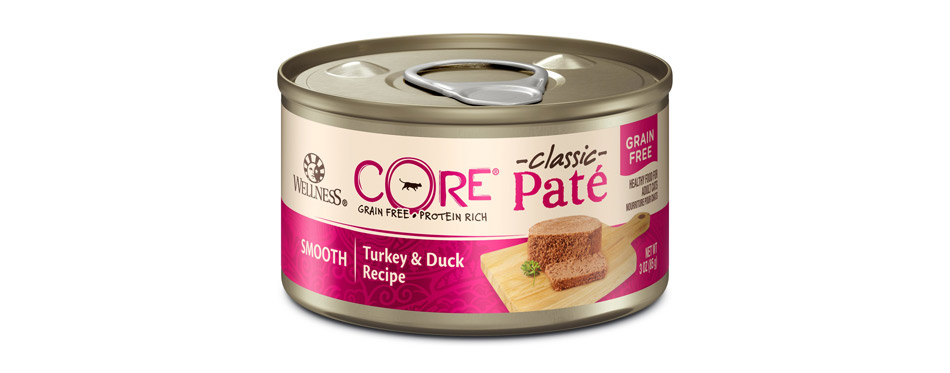
- Carbohydrates: 4.1%
- Brand: Wellness
- Allergens: Pork, Turkey, Flaxseed, Salt (irritant)
- First 5 ingredients: Turkey, Pork Liver, Turkey Broth, Duck, Cranberries
- Primary Proteins: Turkey, Duck, Pork, Duck
- Calories: 212 kcal/5.5-oz can
- Flavor: Turkey & Duck
- Type: Wet Cat Food
- Life Stage: All Life Stages
This turkey and duck wet food recipe is great for diabetic cats on multiple fronts. The carbohydrate percentage is only 4.1%, meaning you don’t have to worry about it aggravating their diabetic symptoms. Additionally, Wellness has filled the first five ingredients with high-quality protein, and superfoods.
Cranberries being among the top five ingredients shows an understanding of how important it is to care for the urinary functions of a diabetic cat. Seeing as feline diabetes can lead to excessive urination, diabetic cats are more prone to developing urinary tract infections until they have transitioned to their proper diet. Though wet cat foods are high in moisture, they shouldn’t trigger excessive urination, so if your cat is still struggling with this after transitioning to wet food then they may need another check with the vet.

- A grain-free, gluten-free, and soy, wheat, corn, and pea-free recipe
- The high caloric content means less food is required per meal
- Recipe contains multiple potential protein allergens for hypersensitive cats
3 Purina Pro Plan Veterinary Diets DM Dietetic Management Formula Canned Cat Food
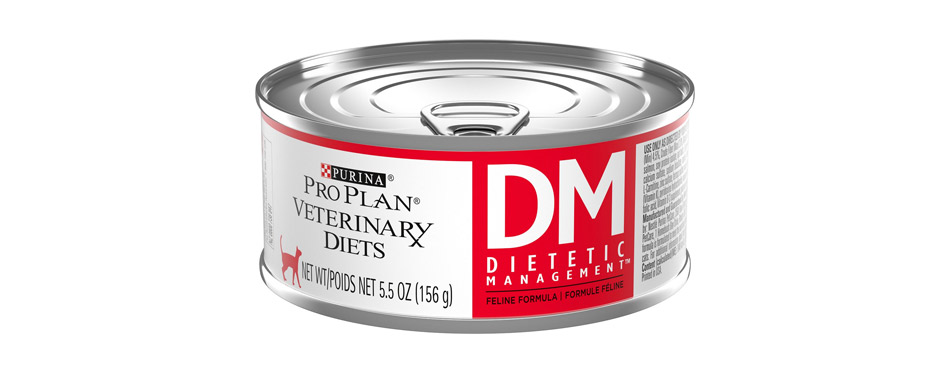
- Carbohydrates: 1.8%
- Brand: Purina
- Allergens: Chicken, Soy, Oat Hulls, Salt (irritant)
- First 5 ingredients: Meat By-Products, Water, Chicken, Salmon, Soy Protein Isolate
- Primary Proteins: Chicken, Salmon
- Calories: 163 kcal/5.5-oz can
- Flavor: Chicken & Salmon
- Type: Wet Cat Food
- Life Stage: All Life Stages
Specifically designed to be fed to diabetic cats, the Purina Pro Plan low carbohydrate diet contains only 1.8% of carbohydrates, massively reducing the risk of a diabetic flare-up post-meal. Though some may be put off by meat by-products being the first ingredient on the list, this simply means that this diet contains a mixture of all parts of the animal including the heart, liver, lungs, and bone. Meat by-products ensure that your cat’s diet will be significantly closer to the type of food they would consume in the wild, making it high in protein, vitamins, and minerals, and low on carbs.
This is also a low-calorie diet, which makes it the ideal overweight diabetic cat food, so they can enjoy the pleasure of flavourful wet foods without having to worry as much as portion sizing. Furthermore, this diet is not only suitable for diabetic cats, but also cats that struggle with enteritis, persistent hyperglycemia, or chronic loose bowels.

- A high-protein and low-carbohydrate recipe
- The formula is specifically designed to help cats with diabetes
- Not advised for use without the recommendation of a veterinarian
4 Tiki Cat After Dark Canned Cat Food
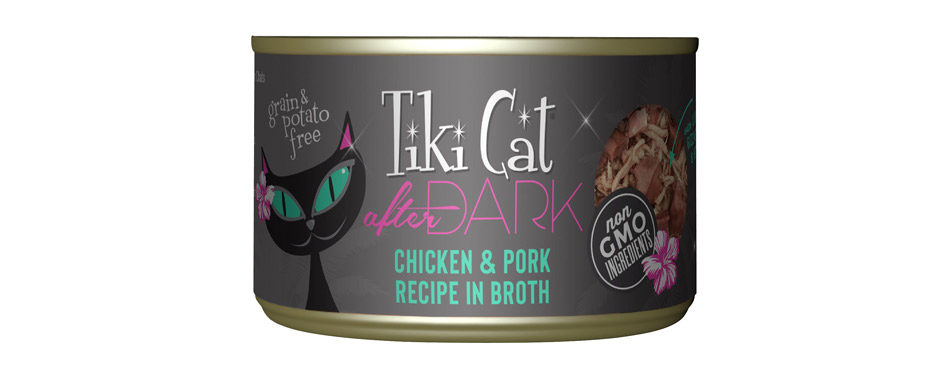
- Carbohydrates: 7.4%
- Brand: Tiki Cat
- Allergens: Chicken, Pork
- First 5 ingredients: Chicken Broth, Chicken, Chicken Liver, Chicken Gizzard, Chicken Heart
- Primary Proteins: Chicken, Pork
- Calories: 129 kcal/5.5-oz can
- Flavor: Chicken
- Type: Wet Cat Food
- Life Stage: All Life Stages Cats
The Tiki Cat After Dark canned food is a little bit higher on the carbohydrate scale, with a total percentage of 7.4%, but this is still well below the limit and very similar to the Ziwi Peak cat food listed above. Though the major benefit of the Tiki Cat After Dark food is the lack of allergens – which is particularly helpful for owners of hypersensitive cats. No grains, no wheat, no soy or corn, and no peas.
This is a delicious, ultra-hydrating meal made with chicken broth as the first ingredient. Followed by various parts of the chicken itself as the following four ingredients, once again showing dedication to maintaining a high standard and emulating a natural diet as much as possible. Furthermore, this is our lowest calorie meal option for cats that have had a particularly hard time with excess weight gain before beginning their treatment and switching diets. Your cat can feel like it’s being fed a hearty meal without the need for reduced portions.

- The formula contains no grains, peas, corn, wheat, or soy.
- The recipe focuses on using all parts of the chicken to replicate a natural diet.
- Chicken and pork are both potential protein allergens with hypersensitive cats
5 Instinct Original Grain-Free Pate Canned Cat Food
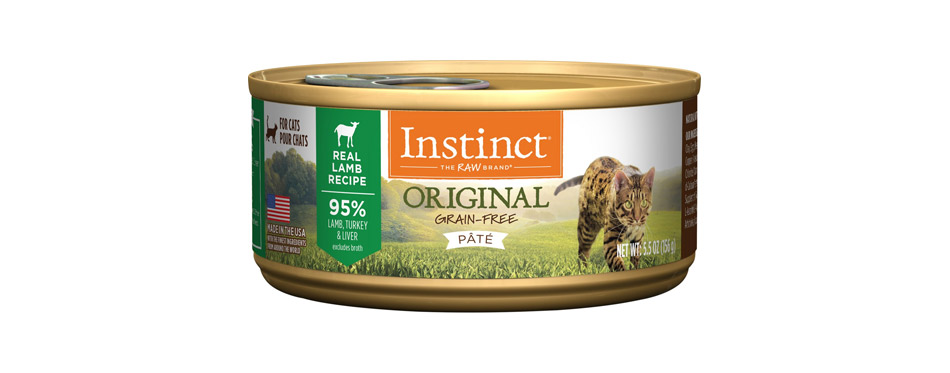
- Carbohydrates: 3.0%
- Brand: Instinct
- Allergens: Turkey, Flaxseed, Eggs, Salt (irritant)
- First 5 ingredients: Lamb, Lamb Broth, Turkey, Turkey Liver, Ground Flaxseed
- Primary Proteins: Lamb, Turkey
- Calories: 206 kcal/5.5-oz can
- Flavor: Lamb, Turkey & Liver
- Type: Wet Cat Food
- Life Stage: All Life Stages
We are very happy to see Lamb and turkey taking up the first for spots on the Instinct Original recipe. Lamb offers not only an abundance of protein, being a high-protein meat source, but it along with turkey also provides plenty of natural fiber to ease digestion and help to settle delicate digestive systems. Fiber also helps cats to more easily process their food and encourages the body to process nutrients more efficiently – providing energy faster.
The only downside to this recipe is that it contains a few allergens, with the egg being a common protein allergy, and salt which is a known stomach irritant for particularly sensitive kitties. However, this delicious food does contain omega fatty acids which help to rejuvenate and maintain your cat’s skin and coat as well as being free from artificial colors and preservatives. It is also filled with superfoods such as blueberries, cranberries, pumpkin, broccoli, kale, and artichokes.

- Heavy focus on protein with 95% protein & 5% vegetables
- The inclusion of omega fatty acids helps to care for skin and coats
- A high-calorie recipe that isn’t ideal for heavy-set cats
What is Diabetes in Cats?
Diabetes is a condition that causes the body to be incapable of responding to or producing the hormone insulin. As a result, you affected cat ends up with heightened levels of sugar glucose in the blood – sugar glucose is the body’s primary source of energy.
In order for a cat’s body to properly absorb the glucose, it needs insulin, which is produced by the pancreas, to access it. It acts as an indicator for the body to know when it should be absorbing more glucose – thus lowering the body’s blood sugar back down to normal levels once used.
If the body is incapable of recognizing when the glucose should be used, then the level of glucose in the blood continues to rise to potentially dangerous levels if left unchecked. It’s estimated that between 0.2-1% of all cats will be diagnosed with diabetes at some point in their lifetime.
Different Types of Diabetes
There are two different kinds of diabetes that cats can develop, with each working in a different way and carrying its own risks.
Type I Diabetes
Type I feline diabetes is when the blood glucose concentration is high as the result of decreased insulin production. This means there is no way for the glucose to begin being processed, resulting in bloody sugar levels rising and cells not receiving the appropriate glucose.
Type II Diabetes
Type II feline diabetes is high blood sugar caused by the cells of the body not responding to insulin as they should. This prevents the cells from processing glucose out of the bloodstream and moving it to the areas that need it.
Signs of Diabetes in Cats
There are several symptoms that can help you to figure out whether there is a possibility that your cat has developed diabetes – though keep in mind that feline diabetes can only be 100% confirmed through a blood test with your veterinarian.
Increased Urination
This is the most common symptom of diabetes seem in both cats and humans. Kidneys are forced to work overtime when a cat is struggling with diabetes. This extra work is in order to filter and absorb the excess glucose in the body. When the kidneys can’t keep up, the excess glucose is excreted as urine.
Insatiable Appetite
Because the body is not getting any energy due to its inhibited capability to obtain energy via glucose, the starved cells will instead trigger a hunger signal to request that the body be given additional energy. This will lead to a feeling of constant hunger. If your cat is constantly begging for more food in between meals and becoming irritable when it has to wait, this could be a sign of diabetes.
Excessive Thirst
Your cat can become dehydrated as a result of excessive urination, this is because whilst they are expelling unwanted glucose, they are also using up fluid from other tissues as well. Naturally, this will cause them to feel more thirsty and drink more often than usual.
Unusual Weight Loss
Despite the escalated appetite, your cat’s body will turn to alternative fuel sources, seeing as it can’t obtain energy from glucose. As a result, they will start to break down fat and muscle beyond their standard weight limit, leading to unexpected weight loss and an inability to maintain a healthy body weight.
Unusual Weight Gain
Alternatively, a diabetic cat can begin to gain weight as the fat cells produce hormones that tell them they’re still hungry. Overweight diabetic cats may struggle to lose weight initially. However, as they are treated and their appetite returns to normal, they will likely begin to shed the weight naturally with daily exercise. Insulin therapy is usually required with cases of severe weight gain to help get your cat’s diabetes under control quicker.
Dipping of the Hind Legs
In rare cases of diabetes where it has gone untreated for a long period of time, diabetic cats can have a “plantigrade” stance. This means the hind legs dip downwards resulting in the hocks being close to or touching the ground. This dipping is triggered by damage to the nerves in the area.
It is worth noting that each of these symptoms, whilst commonly seen with diabetes, can also be signed of other health issues that should be investigated. Therefore, if you notice your cat behaving in this way, be sure to make an appointment with your veterinarian to have them looked over before changing their diet.
Can a Cat Recover from Diabetes?
Feline diabetes cannot be cured, though it can be easily treated. As a result, cats with diabetes are able to live a happy, healthy life so long as treatment is maintained. It is possible for diabetic cats to enter diabetic remission, which means they are capable of maintaining their blood sugar levels without insulin.
However, this doesn’t mean they are cured, and they should be continuously watched for signs of diabetes returning. If a cat does not enter remission within 6-months of beginning insulin injection treatment, they are likely to require lifelong injections.
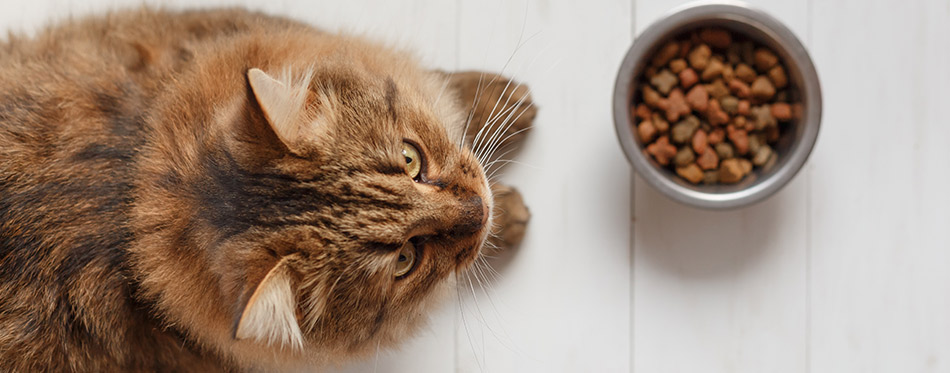
How to Test Your Cat’s Blood Glucose at Home
In order to properly monitor your cat’s blood glucose levels, you will need to be able to check them easily at home. This will prevent you from having to regularly take a trip to the vet and risk traumatizing your cat, making future vet visits much easier. Testing your cat’s blood sugar levels is easy enough to do once you’ve gotten the hang of it – it may take a few tried until you’re comfortable with the process.
1. Get together all of the components you will need
Most owners of cats with diabetes can obtain a glucose testing kit from the vet which will contain:
- A glucometer
- Test strips
- A needle or lancing device
- Cotton balls or gauze
You can also add diabetic-friendly treats to the pack to use positive reinforcement with your cat.
2. Check the expiration date on the test strips
If the strips are out of date then the results won’t be accurate.
3. Find your pet
Before starting the test you need to ensure your cat is calm and comfortable, so take some time to sit with them, stroke them, and calm them down before proceeding.
4. Select a testing site
The two best-recommended testing sites are the ear vain (which can be seen when holding a torch to the back of your cat’s ear), or the paw pad. We would suggest trying both at different times and see which one your cat responds to best.
5. Prep the area
First, you need to clean the area you will be testing. Then use a warm compress, or sock filled with warmed rice, to encourage blood flow. A thin layer of petroleum jelly on the skin can also help a clear blood proplet to form once the skin is pricked or lanced.
6. Insert a testing strip into the glucometer
Once the strip is inserted you’ll want to make sure to keep the device nearby so that you can grab it easily once the blood is available.
7. Prick or lance the area to retrieve blood
You need to ensure you apply firm pressure to the area once it has been cut in order to ensure a proper blood droplet forms and prevent yourself from having to cut the skin a second time, which could agitate your cat.
8. Touch the testing strip to the blood and check the result
Be careful to check where on the strip the blood needs to be collected, and then touch the testing strip to the droplet. The results should take less than a minute to appear on your glucometer’s screen. Be sure to record the result in your cat’s glucose diary. Your veterinarian should be able to help you determine what results are idea for your cat.
9. Clean the area properly
Properly clean the testing site and be sure to dispose of the needle or lance in an enclosed sharps container for safety.
10. Reward your car
Your cat needs to be taught that having a glucose test is not a negative experience, and so be sure to treat them to a low-carb or carb-free snack as a “well done” for their bravery.
What to Consider When Buying a Diabetic Cat Food
Fortunately, buying food for diabetic cats is actually easier than buying for cats with severe food sensitivities, as it’s not specific ingredients you need to avoid, but rather a certain type of ingredient that can be easily checked. But just keep in mind the following points as you peruse:
Keeps Carbohydrates Below 10% (on a dry-matter basis)
We explain this in a little bit more detail further down in the next section, but carbohydrates are the enemy of diabetes. When your cat eats carbs it is eating an energy source that provides energy via glucose. Seeing as the absorption of glucose is exactly the problem with diabetes, it stands to reason that eating food that relies solely on glucose to provide energy is counterproductive.
You need to focus on finding food that provides energy in different ways such as protein. Bad carbs include potato, starch, corn, and soy. However, there are certain carbs that have additional health benefits including vitamins, and minerals. Therefore, if you’re going to have food with carbs in, try to stick with food containing vegetables, fruit, and whole grains.
Dry Food Might Not Work
Most dry cat foods are not suitable for diabetic cats. This is because dry kibble heavily relies on the use of carbohydrates and starch as a large part of the formula, with carbs making up around 25-40% of the overall recipe. If you’re able to find a dry food with a low enough carb content, then it can certainly be fed to your diabetic cat, however, the best diabetic cat foods tend to be wet pouches or canned food.
Grain-free Is Not Necessary
Though we have been led to believe that grains are the route of all evil when it comes to cat and dog food, this is not the case. Grains can easily be part of your cat’s diet without any severe complications. It’s simply a matter of how many grains have been used – once again coming back to controlling the number of carbs in food to keep your cat’s blood sugar stable.
So whilst grains are not necessarily bad for your cat, it’s usually recommended to go with grain-free cat food just to save you the hassle of having to worry about it, and help you to focus more easily on the overall care of your cat.
Things You Should Avoid in a Cat Food for Diabetes
There is only really one thing you should avoid when looking through diabetic cat foods, and that’s a high carbohydrate percentage. The best diabetic cat foods will have a carbohydrate percentage of less than 10% on a dry-matter basis, as previously explained. By “dry-matter basis” we mean that you have to ignore the amount of moisture in the food and calculate the carbohydrates accordingly.
How to Calculate The Carbohydrate Percentage in Cat Food
When perusing the diabetic cat food options, it helps to know how to quickly and easily calculate the carbohydrate percentage. We’ll start this explanation by saying that it may feel complicated to read to begin with, but it is really very simple once you’ve got the hang of it, so just bear with us!
Firstly, you will need to find the guaranteed analysis of the food in question. For the purposes of this explanation, we will be looking at the guaranteed analysis of the Ziwi Peak cat food listed above, which is laid out like so:
- CRUDE PROTEIN: 11.0% min
- CRUDE FAT: 3.5% min
- CRUDE FIBER: 2.0% max
- MOISTURE: 78.0% max
- ASH: 4.0% max
This information can be found on the back of every can and should be laid out in the same manner.
How to Calculate The Carbohydrate Percentage
The way to calculate the average amount of carbohydrates in this food is simply a case of removing the percentages for protein, fat, fiber, moisture, and ash (ignore any other percentages you might see) from the 100% total – the percentage you are left with is the carbohydrates. The full calculation would be as follows:
100 – 11 – 3.5 – 2 – 78 – 4 = 1.5%
This will not be an exact figure, but so long as it’s below 10%, you should be fine. In the case of some foods that have no carbohydrates, the resulting number can dip as low as -3%, this is fine.
How to Calculate Carbs on a Dry Matter Basis
In order to figure out what the percentage of carbs on a dry matter basis is, you will need the percentage from the last calculation to get the final number. For this calculation, you will need the carbohydrate percentage, the moisture percentage, and the 100% total amount of food. The final calculation for dry-matter carbs will look like this:
1.5 (percentage of carbs) ÷ 22 (100% – 78% moisture) x 100 = 6.8%
As a result, you’re left with 6.8% as the total amount of carbohydrates on a dry matter basis.
Are Veterinary Diets Good For Diabetic Cats?
Absolutely. Veterinarians will usually prescription a diet for your cat to maintain in order for them to keep consistent blood sugar levels. However, it is also worth noting that a diabetic diet focuses primarily on reducing the number of carbohydrates your cat is consuming.
Therefore, it is entirely possible to use non-prescription food for diabetic cats and get the same results as prescription cat foods. So long as you are careful to select (or even make at home) a low-carb, high-protein diet, and avoid dry foods, you should be good to go! Just be sure to keep a close eye on your cat’s blood sugar levels with a non-prescription diet, at least until you are sure it’s doing its job.
2 Simple DIY Diabetic Cat Food Recipe Ideas
If you decide you’d rather make your cat’s food fresh so as to ensure that you know exactly what they’re consuming, there is a simple recipe you could use to ensure they’re still getting all of the appropriate nutrients, vitamins, and minerals that they need. Both of these recipes will need nutritional supplements if you’re wanting to completely avoid carbs. You will need to clear with your vet which supplements are appropriate before moving forward with homemade food.
1. Tune and Egg
Ingredients:
- 4 oz tuna (preserved in spring water, not brine)
- 1 x egg
- 1 tbs canola oil
- Vitamin and mineral supplements
Method:
- Hard boil the egg and blanch until cool
- Peel the egg and combine it with the tuna, canola oil, and crushed supplements in a blender.
- Blender to desired texture and serve
2. Beef With The Bone
Ingredients:
- 4 lbs beef with bone
- 14 oz chicken heart
- 7 oz chicken liver
- 2 cups water
- 4 x egg yolks
- 1 tbs salmon oil
- Vitamin and mineral supplements
Method:
- Blend beef on its own first to break down the bone
- Add the remaining ingredients and crushed supplements into the blender and blend until the desired consistency
- Split into separate portions and refrigerate for no longer than three days (can be frozen for up to six months)
Sources:
- Feline Diabetes, Cornell University College of Veterinary Medicine
- 4 Possible Signs of Diabetes in Cats, Boehriner Ingelheim Animal Health USA Inc
FAQs:
Ideally, no. Dry kibble often has a high percentage of carbohydrates as one of the key components of the formula. High carbohydrate cat foods are the enemy of feline diabetes, with the recommended carb percentage not exceeding 10%. Therefore it is better to stick with wet food for diabetic cats to be on the safe side.
A cat with diabetes can live a long and happy life provided the owner is prepared to keep up a low carbohydrate diet, use prescription foods, or administer regular insulin injections to maintain their cat’s blood sugar levels. A diabetic cat’s diet is essential to its health, and so a low carb diet or even a prescription diet will be required to keep them fit and strong. In more severe cases, insulin injection may be required as well.
This is something you would have to check with your vet, as the circumstances can alter the answer. Some diabetic cat owners will choose to inject their cat mid-meal, others will wait until they are finished and then inject them immediately after.
No, diabetes doesn’t cause pain unless there are serious complications due to going without treatment for an extended period of time or insufficient treatment once diagnosed. Typically a cat with diabetes may be hungrier than the average cat or urinate more frequently, but generally, they are happy and healthy.
Diabetes causes the body to be incapable of extracting glucose from the blood, which is the body’s primary source of energy. As a result, the cells that are not receiving energy will trigger a hunger reaction to tell the cat that it is in need of energy and needs to consume more food. This cycle is constantly repeated unless the cat is treated for diabetes and provided with insulin (which is the essential component to extracting glucose from the bloodstream).

